A healthy baby full of happiness is the dream of every mother. And the first step in making your cherished desire come true is proper nutrition for the mother during breastfeeding. Of course, you don’t want to sit on solid oatmeal for such a long period of time. Therefore, walking past the shelves of a grocery store, every mother wonders whether she can eat this or that product. Walnuts often raise doubts: the product is certainly healthy, but is it allowed? We found out what walnuts are like during breastfeeding and want to share important information with you.
What is good for a mother is not always good for her baby when breastfeeding. Each variety of nuts can have a different effect on a baby’s sensitive digestion. Breastfeeding is not just a child receiving nutrients, it is also a special first dialogue between a mother and her baby, establishing a strong connection between them that will last a lifetime. I don’t want to spoil such a wonderful process with the whims and painful sensations of the baby, which often occur after eating the “wrong” foods. I wonder what pediatricians think about walnuts during breastfeeding?
Nut milk - what is it?
This liquid is prepared from pureed nuts, and the finished milk takes all the nutrients from them. Most often, almonds, Brazil nuts, cashews, hazelnuts, pistachios and walnuts are used for its preparation. Dry sunflower, pumpkin, poppy and sesame seeds are also used.
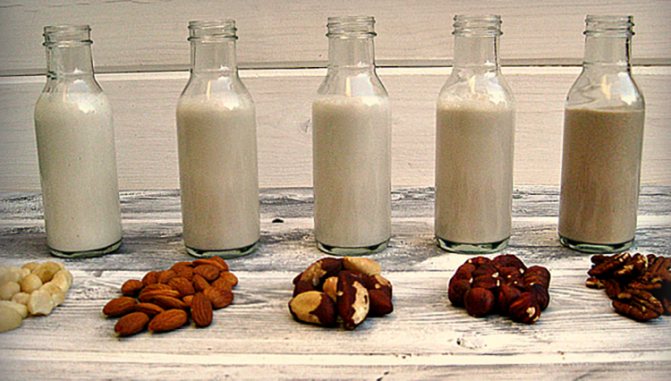
Milk is very nutritious in its composition , since all the vitamins and minerals from the nuts end up in it. You can buy it ready-made, but here you need to rely on the composition of the product, since many manufacturers add sugar and preservatives to it, extending the shelf life. You can cook it yourself, it's not difficult at all.
Selection of nuts and their storage at home
When buying walnuts, you should adhere to the following rules:
- Preference should be given to nuts in shell. This shell reliably protects the kernel, thereby increasing the shelf life of the product. The shell must be intact and dry, without cracks, stains or plaque.
- You should not buy nuts that have traces of mold or oily stains on their surface. There is a high probability that they have gone rancid.
- Fresh nut kernels should be golden and uniform in color.
Since walnuts during breastfeeding, according to doctors and nursing mothers, increase the calorie content of breast milk and its quality composition, they should be consumed all year round. Moreover, they can be stored for quite a long time, while observing the following conditions:
- without peeling;
- at a temperature of 15-20°;
- in a wooden box, cardboard box or canvas bag.
Shelled walnuts should be stored in the refrigerator for up to 1 month or in the freezer for 2-3 months.
Causes and signs of low hemoglobin
Any decrease in hemoglobin concentration is a consequence of various diseases. To determine its level, a general blood test is prescribed.
Anemia can be caused by:
- disorders of the hematopoietic organs;
- rapid destruction of red blood cells;
- heavy bleeding;
- deficiency of vitamins and elements.
Problems with the functioning of organs that participate in the process of hematopoiesis can be congenital or arise under the influence of external adverse factors, infectious diseases, or injuries.
Including nuts in your daily menu if you have low hemoglobin will help normalize the situation. But in many cases, changing your diet is not enough. Most often, patients need drug therapy.
You can notice a decrease in hemoglobin by characteristic signs:
- pallor of the skin and mucous membranes;
- increased fatigue;
- lack of strength, constant weakness;
- sleep disorders;
- dyspnea;
- headaches, dizziness.
All emerging signs of anemia are caused by oxygen starvation of tissues. It occurs in cases where the body does not receive enough iron or this element is not absorbed.

An unbalanced diet, nutritional deficiencies in the diet, a number of diseases of the digestive system and hematopoietic organs can lead to a decrease in hemoglobin levels
Daily iron requirement
In the absence of serious health problems, the development of anemia can be prevented through proper nutrition. You need to include foods that contain iron in your diet. Nuts, meat and offal, buckwheat, some fruits and vegetables are useful for low hemoglobin.
Iron must be supplied to the body through food daily. This is the only way to prevent a deficiency of this element. The consumption rate directly depends on the gender and age of the patient. Women need from 15 to 25 mg of this element per day; during pregnancy and lactation, the need increases to 25-27 mg. For adult men, it is enough for 8 to 15 mg of iron per day to enter the body with food.
In children, the requirement varies from 7 to 13 mg depending on age. The older the child, the more iron should enter his body.
Acceptable standards
We found out that the answer to the question whether mom can have walnuts is positive. All that remains is to find out how many nuts you can eat to get the maximum benefit from them:
- The amount of product consumed per day can be 4-5 pieces. They are best eaten as a snack between breakfast and lunch.
- The high calorie content of the “royal acorn” allows us to classify it as a product that quickly saturates and energizes. Therefore, it is useful to take treats with you, for example, when a mother goes for a long walk with her child.
- Even if you do not have allergies or illnesses that prevent you from eating nuts, when you first try a product while breastfeeding, special emphasis should be placed on gradual feeding. For the first time, eat half the core of one thing and monitor your baby’s reaction for several days.
The use of walnuts to increase lactation is legendary. However, they have no scientific basis. The myth about the effectiveness of walnuts for lactation appeared due to the fact that the nutrients in the product provide the calorie content of breast milk. This really quickly saturates a baby who is fed milk, but they cannot influence lactation itself.
Reviews about Improving lactation with folk remedies
Unfortunately, not all women who have just given birth to a child have good lactation (breastfeeding). Insufficient or no breast milk depends on many factors. Sometimes these factors do not depend on the young mother, but in most cases these causes can be eliminated (about 80%). Let's consider the main reasons that negatively affect lactation, but which can actually be eliminated: - poor nutrition during breastfeeding; - all kinds of stress, anxiety and worries; - feeding the baby not on demand, but according to a schedule; - reluctance to breastfeed the baby; - restless and constantly crying child. One day I also encountered this problem. I tried many medications to improve lactation, but nothing really helped, I even wanted to transfer my son to artificial feeding. But in time I met an old friend who gave me several folk remedies that she had tested and really helped. I want to share these wonderful recipes with you, maybe they will be useful to you and help you solve this problem, as they once helped me! All folk remedies should be used with extreme caution, starting with small doses. You should constantly monitor your child’s reaction; if the baby does not have a negative reaction, then the amount of the product can be gradually increased. 1. Sour cream and caraway mixture Take 5 grams of crushed caraway seeds and 250 grams of sour cream. Mix well and put on low heat, bring to a boil and simmer for 2-3 minutes. Cool the resulting product and take 1 tablespoon 3 times a day. Store it in the refrigerator. Mix well before each use. On the first day of use, reduce the dose to 1 teaspoon to check the child's reaction to this recipe. 2. Milk with walnuts Grind 100 grams of peeled walnuts well (you can use a meat grinder). Add 1 tablespoon of sugar to the nuts. Mix well and pour boiling milk (0.5 liters). Cover with a lid and leave for 3 hours. Consume 4-5 tablespoons immediately before feeding. 3. Herbal tea Mix 50 grams of nettle and lemon balm, chop well and mix them. Pour 1 tablespoon of this mixture into a thermos and pour 0.5 liter of boiling water. Infuse tea for 2 hours. Drink half a glass 2 times a day. You can add a little sugar to your tea. 4. Milk with carrots Add 3 tablespoons of freshly squeezed carrot juice to 1 glass of warm milk. Mix well and drink a glass 2 times a day. It is necessary that the milk be boiled. You can also replace milk with not too heavy cream. 5. Juice from fresh nettle If it is spring or summer outside, then young nettle will help improve lactation. Squeeze 0.5 cups of juice from fresh herbs. Dilute the resulting juice with 1 glass of water. Bring to a boil, stirring constantly. Cover with a lid and let sit for 2 hours. Take 1 teaspoon 4-5 times a day. Store the resulting product in the refrigerator. General tips for improving lactation: - eat right; - drink 2-3 liters of fluid per day; - adjust your baby to your breast more, feed him on demand, and not according to a schedule; - less stress, more positive emotions; — often pick up the child and hold him close to you. Constant skin-to-skin contact between mother and baby stimulates lactation; - walk more in the fresh air (at least 2 hours a day); - if there is such an opportunity, then rest more; - take vitamins for nursing mothers. Be patient and everything will work out! The main thing is not to be lazy! Health to you and your children!
The best foods for excellent lactation
There are foods that you can eat periodically to optimize breast milk production, and the main ones are described below.
1. Warm tea
The easiest option is to drink green tea with honey (not strong) or weakly brewed black tea with milk. If the baby or mother is prone to allergies, it is better not to overuse honey, but add milk to the tea . If you drink the drink 30 minutes before feeding your baby, milk production will definitely increase.
2. Cumin and bread with cumin
You can chew cumin, or eat black bread with its seeds. You can also prepare yourself a cumin drink: brew 1 teaspoon of cumin with a glass of boiling milk and leave for 2 hours. You need to take half a glass of this drink 15 minutes before feeding.
3. Uzvar
Uzvar is a compote of dried fruits (plums, pears, apples, apricots), a little sugar, water. It is recommended to take a glass of uzvar twice a day. It will enhance lactation and is rich in vitamins.
4. Clean water
Simple, still and clean water is also suitable for increasing milk production. You should drink up to 2 liters per day, then there will be no problems with feeding. But immediately before feeding, it is better to drink a drink with a more pronounced lactogenic effect (for example, a glass of milk or a cup of green tea).
5. Nuts
The mass of useful components in nuts will not only allow the baby to grow better and improve health, but also to be fed with breast milk in sufficient quantities. Every day you need to eat 2-5 pieces of almonds (without salt or roasting), but do not overuse them because of the risk of abdominal pain in the baby (it causes gas formation in the child and can cause severe constipation). Other nuts (walnuts, pine nuts, Brazil nuts) work similarly, but they are quite fatty. You can also prepare a cedar cocktail: 1 table. pour a spoonful of pine nuts into a glass of water overnight, boil it in the morning, add honey and drink.
6. Dill tea
Our grandmothers drank dill tea as a lactogenic remedy. Brew a spoonful of dill seeds with 200 ml of boiling water and leave overnight in a thermos. Drink half a glass twice a day. You can replace dill seeds with caraway seeds and anise. Based on these plants, you can prepare another herbal tea: 20 g each of anise and dill seeds, 30 g each of fenugreek seeds and fennel fruits, grind and stir. Pour 1 teaspoon of the mixture into a glass of boiling water, leave and take a glass of infusion 2 times a day 15 minutes before feeding.
You can make your own dill milkshake. To do this, mix crushed dill seeds with kefir, season with nutmeg, add salt, strain and drink before breakfast.
However, it is worth remembering that both anise and dill can cause allergies.
7. Herbal tea
Plants that increase lactation can be purchased at any pharmacy. Popular among them are oregano, nettle, lemon balm, dill, anise, and hawthorn (berries). You should make mixtures from them (combine in equal proportions), brew a spoonful of raw materials with a glass of boiling water and take 100 ml three times a day. Consulting a doctor before consuming any herbs is mandatory ! They can cause colic or allergies in the baby!
8. Nut milk
Nut milk is easy to prepare. Grind 50 g of walnuts, pour in 250 ml of hot milk, cook until slightly thickened. Add sugar to the drink to taste, take 70 ml. before the next feeding (30 minutes).
9. Lactogenic products
There are foods that can enhance the production of prolactin, a hormone responsible for and supporting lactation. Many of them are of animal origin and are high in protein, so they should be included in the menu according to the daily requirements for lactating women. Here is the list of products:
- Low-fat meat soups, broths;
- Lean fish and meat;
- Hard cheese, Adyghe cheese, feta cheese;
- Fermented milk food.
From non-animal foods, seeds, carrots, honey, as well as vegetables and fruits that contain a lot of fiber accelerate the production of the necessary hormone.
Read also: list of products allowed for breastfeeding
10. Juices
Freshly squeezed juices. Juices prepared at home are much healthier than store-bought ones; they should be taken immediately, without standing in the refrigerator. The juice of carrots, currants, and blackthorn berries will do a great job of increasing milk production. It is important that the juices are fresh, without preservatives, diluted with water.
11. Barley water or barley coffee
Barley coffee is an excellent tea substitute. It is better to drink such drinks with honey, sugar and milk. These barley drinks can be purchased in the health food section of the store.
12. Radish with honey
There is a drink that does not have a great taste, but it works no worse than juices. This is radish juice. Squeeze out the juice, dilute it equally with water, add a spoonful of honey to a glass of liquid. If you have gastrointestinal diseases, you should not take this drink.
Read also: 8 myths about milk shortage
13. Dandelions
Dandelion has the best effect for increasing lactation among the herbs. It can be applied in the following ways:
- Grind fresh young dandelion leaves in a meat grinder, squeeze out the juice, add salt, let it brew for 30 minutes, and drink 100 ml 2 times a day in small sips. To improve the taste, you can add lemon juice, honey, sugar.
- Dandelion decoction: add a glass of boiling water to 1 teaspoon of crushed dandelion roots and leaves and leave for an hour. Then strain and drink 50 ml 4 times a day for 30 minutes. before meals.
- Dandelion milkshake. Mix a glass of milk with 4 glasses of kefir, add 1 tbsp. a spoonful of chopped dill leaves, dandelion petals, 10 g of ground walnuts and beat with a mixer. Take half a glass for breakfast.
14. Ginger tea
Peel, chop and boil the ginger root in a liter of water for 3-5 minutes. Cool, drink 50 ml 4 times a day. If desired, you can flavor the tea with honey and lemon.
15. Vitamin mass
From dried fruits you can cook not only compote, but also prepare vitamin mass. To do this, rinse 100 g of dried apricots, figs, raisins, prunes well, add the same amount of walnuts or pine nuts, grind everything into a homogeneous mass. You can put honey in it to taste. You need to eat the vitamin “dish” half an hour before feeding the baby, washed down with warm tea.
16. Hercules
If you eat fiber-rich cereals for breakfast, this will not only be beneficial for the young mother’s intestines, but will also increase milk production. Oatmeal is especially good for this purpose. You can cook porridge in water or milk, eat muesli, or pour water over the oatmeal, leave it overnight and consume it with kefir. Porridges go well with dried fruits and honey.
Read also: how to restore lactation - 10 recommendations
17. Buckwheat
Experts advise rinsing buckwheat, then frying it in a frying pan and eating it like seeds. This will also have a beneficial effect on lactation.
18. Watermelon
Watermelons are an excellent product for lactation - they should be purchased only during their ripening season (from August). You should not buy watermelons before August; they can be dangerous due to their high content of nitrates and pesticides.
19. Carrots and onions
Onions and carrots are easy to get, and their ability to influence milk production is also high. Fresh and boiled carrots and onions have a positive effect on lactation, so try to add them to all dishes.
20. Salad
To increase lactation, it is useful to eat any kind of lettuce that is seasoned with olive oil or sour cream.
Additional tips for new mothers during lactation:
- Do not be nervous;
- Maintain a daily routine and sleep schedule;
- Rest more;
- Avoid stress and overload;
- Be sure to feed your baby at night.
A children's goods store or any pharmacy offers ready-made teas and infusions for women during lactation. They act purposefully to increase milk supply. But it is worth remembering that too much influence on lactation can result in stagnation of milk in the breast and the development of mastitis, so everything is good in moderation!
We also read:
- What foods will help enhance lactation?
- How to increase lactation?
While breastfeeding, you may have noticed that your milk supply is uneven. And sometimes it can disappear. Do not rush to feed your baby with formula. There is another way out!
Useful qualities and harm of walnuts
When a nursing mother wants to treat herself to a nut, it is worth considering whether walnuts can be consumed while breastfeeding, whether they are harmful for the baby and for the woman who recently gave birth. If we talk about walnuts while breastfeeding, there are three bad news for lovers of this delicacy:
- This product is very high in calories. If you abuse it, it will be very difficult to get rid of the kilograms gained during pregnancy. There’s no need to add too much, because it’s so difficult to limit yourself to a few kernels when they are so tasty.
- Most of the calories in nuts come from lipids. It can be said that Greek kernels consist almost entirely of fat, and this must be taken into account by those who calculate the amount of nutrients in the diet.
- The essential oil contained in nuts is a strong allergen. During breastfeeding, harmful substances easily penetrate into the milk, and from there into the baby’s blood. It is impossible to tell in advance whether a nursing mother can use this product until you try it. However, if one of your relatives has a predisposition to allergies and diseases such as asthma, it is better not to risk it and hold off on introducing kernels into the diet. In addition, the child’s reaction may not occur immediately after the mother eats food, but may have a cumulative effect and appear at the most unexpected moment.
How many calories and fats will enter the body if you eat 100 g of kernels:
- Kcal - 648;
- proteins, g - 15.4;
- carbohydrates, g - 10.2;
- fats, g - 65.
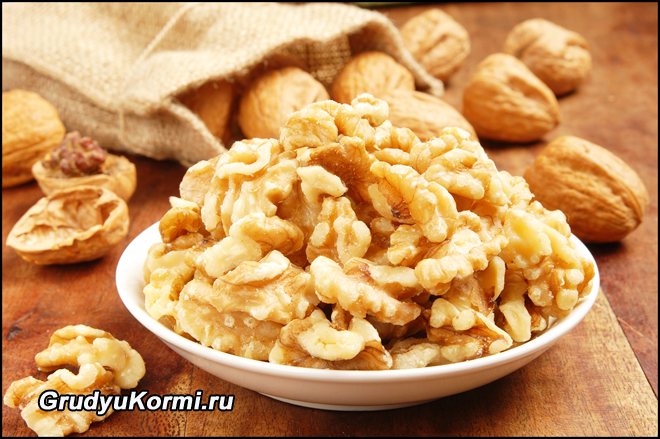
In addition, the fruits contain: But if you look carefully at the composition, it becomes clear that in the absence of allergies, nursing mothers need and can eat walnuts. There are not many carbohydrates in them, which means that with moderate consumption there will be no harm to the figure. The second good news: walnut oil is very healthy, so you can eat it safely while breastfeeding, taking moderation.
- complete protein;
- unsaturated fatty acids;
- essential amino acids;
- provitamins A;
- essential oils;
- tannins;
- vitamin C.
If mom eats a handful of nuts a day, her immunity will be strengthened and the incidence of colds will decrease. Greek nuts are useful for anemia, liver diseases, pathologies of the cardiovascular system, and gastrointestinal disorders. The oil protects blood vessels from “bad” cholesterol and fights the deposits of atherosclerotic plaques. The beneficial effect on the baby’s body is expressed in calming his nervous system and sound, healthy sleep.
Thus, during lactation, nursing mothers can eat walnuts, the main thing is to make sure that there are no negative reactions and not to get too carried away with this tasty but high-calorie product.
Products that reduce lactation
You will have to remove foods from your diet that reduce lactation by retaining fluid in the body. These include:
- hot seasonings, spices;
- parsley, sage, mint;
- smoked meats;
- canned foods.
Those women who regularly consume these products will not be able to avoid problems with lactation: they will have much less milk with such food incontinence. And if they do not take urgent measures to somehow improve lactation and exclude these products from their menu, the baby will soon have to be switched to artificial feeding. To make more milk, it is recommended to prepare various folk remedies.
Uzvar is a wonderful folk remedy for increasing lactation; in addition, it saturates the young mother’s body with the vitamins she and her baby need.
What is nut milk?
Nut milk has long been part of the monastic diet. It fits perfectly into the Lenten menu, suitable for strict vegetarians and people who suffer from lactose intolerance. Milk is obtained from a variety of nuts - walnuts, pine nuts, almonds, cashews, hazelnuts. There are even recipes with pumpkin seeds and sesame seeds. All you need for cooking are unroasted nuts and plain water. These ingredients will produce real milk, only with a more pleasant taste than traditional cow's milk.

Preparation: soaking nuts
Before you start making milk, the nuts should be soaked. There are different opinions on how long to do this, but the best way is to soak them overnight.
Then you need to dry them at a temperature no higher than 44 degrees in a dehydrator, or simply at room temperature if the air in your house is dry enough.
Soaking nuts is necessary to remove enzyme inhibitors and activate the enzymes themselves. The seeds can also be soaked before cooking if desired.
Store-bought cashews, in our opinion, can no longer be called alive, so there is little point in soaking them, but some do this too.
Periods of lactation crisis: when the baby does not have enough milk
Most often, a crisis occurs 3-6 weeks after the birth of a child and can repeat at 1 month, then at 3, 4, 7. For young mothers, this happens in different ways: some do not feel a decrease in lactation, for others, crises may deviate for a month from "graphic". The baby's well-being and behavior will tell you that he does not have enough milk.
Weigh the baby. If he has gained less than 500 g in a month and you notice that the baby has become lethargic and capricious, take action.
Take the test. Do not put disposable diapers on your baby for 24 hours and breastfeed him exclusively. Find out how many times he wet his pants. Moreover, if the wet spots were small, count two as one. In total you should get at least eighteen. Otherwise, increase your lactation!
Peanut
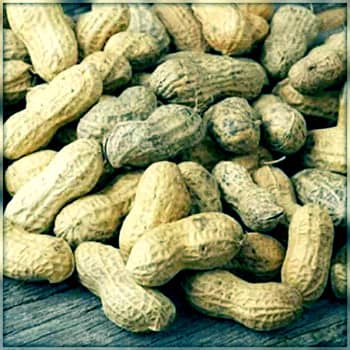
Eating peanuts is a great way to increase the amount of protein in your diet, while it is widely available and provides several essential nutrients.
Although peanuts are technically a legume, meaning they belong to a group of foods from a specific plant family, most people think of them as a nut; contains a range of polyphenols, antioxidants, flavonoids and amino acids: studies have shown that all of these components are beneficial to human health.
100 g of peanuts contain 567 calories and the following amounts of other nutrients:
- protein: 25.80 g
- fat: 49.24 g
- carbohydrates: 16.13 g
- fiber: 8.50 g
- sugar: 4.72 g
The fat in peanuts is mostly healthy monounsaturated and polyunsaturated fatty acids (PUFAs), although these nuts contain lower amounts of saturated fat.
100 g of peanuts also contain many minerals, including those listed below:
- calcium: 92 milligrams (mg)
- iron: 4.58 mg
- magnesium: 168 mg
- phosphorus: 376 mg
- potassium: 705 mg
Peanuts also offer the benefit of being more affordable than many other nut varieties.
What are the beneficial qualities of nuts for ulcers?
Various nut fruits consist mainly of oils that regulate tissue metabolism. Strengthening metabolic processes helps to quickly restore damaged cells, including those damaged due to the formation of ulcers.
A diet for stomach damage involves light meals containing plenty of fluid. Many people do not get enough of this food and remain hungry, which negatively affects their well-being. In this case, crushed nuts for ulcers are an ideal food component, since they are quite filling and nutritious, and most importantly, healthy.
The vitamin and mineral composition contained in the fruits enriches the body and heals it, which is necessary for a person to live a normal and fulfilling life.
Nuts are rich in their composition, which is necessary to restore normal blood flow. In case of illness, blood flow helps to carry oxygen to damaged tissues for their rapid recovery.
Nuts need to be ground in a blender with water.

Drain and rinse your soaked nuts, then transfer them to a blender along with 2 cups of water. In general, the ratio to follow is 1 cup of nuts to 2 cups of water. Press the pulse button several times to break up the nuts, then run the blender for 3 minutes without interruption. The resulting liquid should look smooth, even if there is a lot of pulp inside.
Restrictions on the menu during lactation
There are foods that can harm milk production in a woman’s body. They retain water in the tissues, so milk production may slow down. Such food should be absent from the mother’s diet because it is harmful to the baby, because we are talking about:
- Smoked products (meat, fish), especially hot smoked products;
- Over-salted food;
- Hot seasonings, spices;
- Canned foods;
- Food additives (monosodium glutamate, preservatives, etc.).
Among the seemingly harmless tea herbs and garden herbs, there are also “disturbers” of milk production. These include sage, mint, parsley, and they should not be on the menu at least in the first 2-4 months of lactation.
Read also: what a nursing woman should not eat
How to choose condensed milk
In order to correctly navigate the choice of product, you must remember that not all manufacturers make high-quality products that meet state standards. In many samples you can find harmful additives, which, if used systematically, can cause irreparable harm to human health.
The range of modern condensed milk is very wide. On store shelves you can find the following types of condensed milk:
- Condensed milk with added sugar is used for making confectionery products. For breastfeeding mothers, tea with such condensed milk can be introduced into the diet from the third month of the baby’s life.
- Condensed milk with the addition of cocoa is a rather sweet mass that can be diluted in small quantities with boiling water and consumed as a drink. During lactation, it can be consumed from the fifth month of a child’s life.
- Condensed milk with coffee content – suitable for preparing a coffee-flavored drink. It is better for nursing mothers to use from the fourth month of the baby’s life, after making sure that there is no allergic reaction to the product.
Products that improve lactation
To improve lactation, young mothers need to include drinks, dishes, and individual foods that increase breast milk production in their daily menu. These include:
- warm tea: black (weak) with milk or green with honey - it is recommended to drink half an hour before feeding the baby;
- cumin: chew a small amount of cumin seeds daily or eat bread with this cereal;
- fresh almonds, pine nuts, walnuts (be careful: they can cause excessive gas formation and constipation in the child);
- herbal teas (from oregano, lemon balm, nettle, dill, hawthorn, anise);
- juices: carrot, currant, blackthorn;
- meat, but low-fat broths and soups,
- fermented milk products, milk, feta cheese, Adyghe cheese;
- carrots, watermelons, onions, lettuce;
- buckwheat, rolled oats;
- honey;
- seeds, nuts;
- barley coffee with honey and milk (the product can be found in a regular store);
- ginger.
The right breakfast for a mother who wants to improve lactation: oatmeal porridge with dried apricots, milk and a few walnuts.
By including enough of these healthy foods in your diet, women can be sure that they will have more milk within 3-4 days of the new diet. However, there are products that have exactly the opposite properties - they should be avoided by those who have problems with lactation.
Too spicy foods, as you know, are categorically not recommended to be consumed while breastfeeding
Other alternatives to regular milk
Nut milk is rich and thick, but there are other alternatives. You can choose what to add to your own recipe, use your imagination and get extra pleasure from it.
Excellent milk is obtained by mixing 40% flax, 50% almonds and 10% cashews, flavored with cinnamon, cardamom and nutmeg. You can vary the degree of sweetness, it is always at your discretion.
We recommend the following healthy sugar alternatives to add sweetness to your milk:
- stevia;
- dates;
- honey;
- syrup;
- cane sugar;
- Apple juice;
- maple syrup.
Stevia can be used in combination with other sweeteners, such as apple juice. This will mask its own taste and enhance the sweetness.
Tea with condensed milk during breastfeeding
In the modern world there are many opportunities to obtain the necessary information. Before introducing tea with condensed milk during lactation, reviews about the use of this product by nursing mothers are still worth studying. After all, sometimes practical advice can be very useful.
Do not forget about the opinion of pediatricians and breastfeeding specialists.
Contraindications for use
- Since condensed milk contains cow’s protein, it is definitely not suitable for babies with lactose intolerance.
- Condensed milk consumed by the mother can upset the digestive system, cause diarrhea or constipation, increase gas formation and cause colic.
If there is mucus or foam in the child’s stool, this is a sure indicator that there is lactose deficiency.
- An allergic reaction of a baby to condensed milk is also dangerous. It may occur due to individual intolerance to the product.
The first use of condensed milk during lactation is possible from the third month of the baby’s life, in small quantities. You need to start by adding the product to tea; over time, you can take the product yourself, but not in large quantities.
Composition of breast milk
What does milk consist of? Breast milk contains a unique complex of vitamins, microelements, proteins and carbohydrates (in an easily digestible form). Moreover, the composition of this valuable nutrition changes not only depending on the age of the child, but also throughout each feeding. All the most useful things go to the baby.
- The baby receives early milk as soon as he begins to eat. It looks watery and “blue”. It makes up 90% of all milk. Thanks to it, the baby quenches his thirst, because early milk contains a lot of water and vitamins and minerals dissolved in it.
- Later, milk appears at the end of feeding. It is the most caloric: more than half of its composition is fat. Therefore, late milk is opaque and white. It gives energy.
- It is important that the baby receives both early and late milk. To do this, apply it to one breast and wait until it is completely saturated. If you notice that the baby has drunk everything, put him on the other breast. In this case, start the next feeding with her.
- Do not remove the baby after he has nursed for 15-20 minutes. Later, milk is usually sucked intermittently. The child wants to take a break, because this milk is thicker. It takes a little effort.
Save the remaining nut mixture

Before you throw away the remaining "pulp," consider saving it because it's still full of the nutrients that make nuts so valuable, like fiber and protein. Try adding it to granola, blending it with other smoothie ingredients, or using it to make pancakes, muffins, or waffles. You can even use it to make a very unique pizza crust.
Cocktail recipes to increase lactation:
Recently, smoothies have become very popular - cocktails that are prepared using a blender - submersible or in a special bowl. They have earned popular love for their ease of preparation - you just need to put a little of this, a little of that in a container, add ice and press the button. If you use products that increase milk lactation to prepare such cocktails, you can kill two birds with one stone - both help the problem and save time on cooking.

Beneficial properties of hazelnut milk

The unique combination of components present in the drink determines the benefits of hazelnut milk for the body:
- Sedative effect on the nervous system
. The product normalizes sleep, relieves chronic fatigue, reduces irritability, gives more energy and prevents outbursts of unmotivated aggression. - Activation of metabolic processes
. The components of hazelnut milk stabilize redox reactions, stimulate fat metabolism and accelerate the burning of excess calories. They also have choleretic and laxative properties. - Strengthening the immune system
. Helps the body to better resist the harmful effects of viral and infectious agents. It also makes it easier to combat allergies. - Normalization of the cardiovascular system
. Unlike animal milk, hazelnut milk does not contain saturated fat and cholesterol, so your blood vessels will not become clogged with plaque. The walls will strengthen, become more elastic, and the activity of the heart muscles will improve. Hematopoietic processes are also normalized and microcirculation is accelerated. - Strengthening tooth enamel
. Thanks to the presence of calcium and phosphorus, the drink accelerates the strengthening of bone tissue and restores it. - Positive effect on the gastrointestinal tract and stabilization of digestion
. The components of hazelnut milk have a good effect on the mucous membrane, preventing bloating, constipation and diarrhea. At the same time, the process of food absorption is normalized, heavy metal salts, free radicals, and toxins are removed. - Preventing the development of malignant tumors
. Thanks to the presence of paclitaxel, hazelnut milk inhibits the uncontrolled division of cells that are capable of invasion into adjacent tissues. - Accelerate muscle building
. It’s not for nothing that athletes include hazelnut milk in their diet. The drink promotes the production of the male reproductive hormone – testosterone. And thanks to the presence of protein, muscle fibers are formed and strengthened. - Improving breast milk production
. The components of the drink activate the mammary glands and make mother's milk more nutritious.
In addition, hazelnut milk has a positive effect on brain activity, memory, and the functioning of the adrenal glands and pituitary gland.
Some general tips
In order to improve lactation, women are advised to follow a few simple tips that doctors usually give in such cases. They are aimed at stimulating the functioning of the mammary glands and increasing the amount of breast milk. They relate to the lifestyle of a young mother.
- Drink at least 1.5 liters of high-quality (filtered, mineral) still water per day.
- Special teas to increase lactation.
- Try to rest more in any free minutes, do not overwork.
- Get enough sleep: a nursing mother, according to doctors, needs at least 10 hours of sleep a day.
- Two hours a day - walks in the fresh air.
- Avoid stress, domestic and family quarrels and worries, do not be nervous.
- Avoid excessive physical activity.
- No weight loss diets.
- Frequent feedings (at least 10 times a day).
- Do not give up night feedings, which actually contribute to the production of prolactin in the female body, a hormone that improves lactation.
- Do things you love that will give you positive emotions. This could be knitting, reading, or even watching your favorite movie. Grandma or dad can stay with the baby at this time.
- Do special self-massage at home. Wet your palms generously with castor oil. Place your left hand under your chest, your right hand on it. Make light, massaging movements in a clockwise direction. Avoid getting oil on the nipple.
- Sign up for a massage with a specialist, but be sure to warn him first that you are a nursing mother.
In addition to these recommendations, which mainly affect the lifestyle of a nursing mother, her diet is very important. It should include products whose consumption increases milk significantly.
Ginger is one of those foods that promote milk production, but you shouldn’t get carried away with it: strictly follow the recommended servings
Tasty and healthy flax milk
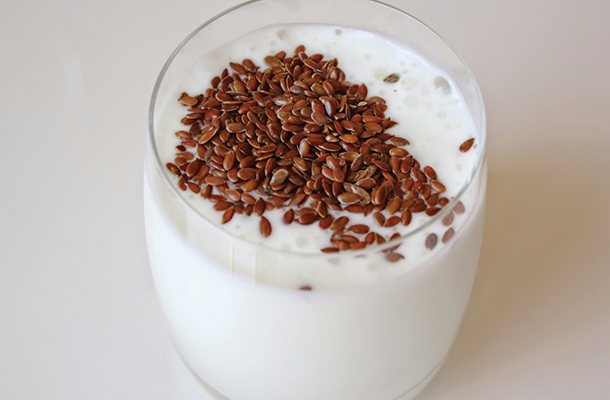
Flaxseed contains many healthy fats (omega-3) and is rich in lignans (75-800 times more than other plant foods), which are antioxidants and stimulate the central nervous system. There is no need to soak or sprout them.
Dates, maple syrup, cane sugar and honey go well with flax milk. Honey should be used unless you plan to heat your homemade milk, for example to make oatmeal, in which case it is better to use other natural sweeteners.
Ingredients:
- a third of a glass of flaxseed;
- 3-4 glasses of water;
- gauze or other filter material;
- a tablespoon of honey;
- a quarter teaspoon of vanilla.
Cooking method:
Mix flax and water in a blender until a thick consistency is achieved. Add honey. Use immediately or chilled. Both brown and golden flax can be used, but the latter produces a milder flavor.
Foods that should not be consumed if you need to increase lactation.
We figured out what foods increase milk. Now we need to talk about foods that reduce lactation, so that you can exclude them from your diet or reduce their consumption to a minimum. There are no secrets here - everything that retains fluid in the body is detrimental to lactation.
Dishes with spices, especially hot ones, not only interfere with the establishment of good lactation, but also have a negative effect on the baby’s tummy if he is sensitive to your diet. Ginger, cumin, cinnamon, barberry or a drop of garlic are allowed spices that can be used to diversify almost any dish without harm to breastfeeding. The rest will have to wait.
The use of some herbs, such as sage and mint, is not advisable if you want to improve lactation. Many women have reported decreased milk production after regularly consuming these herbs.
Salt in large quantities is also an enemy to good lactation, as it retains water in your body. You shouldn’t give it up completely, but you still need to know when to stop.
Contraindications
Definitely, any nuts should be avoided during an exacerbation of a stomach ulcer. But we should also not forget about the high calorie content of the product. In large quantities, kernels can cause constipation. In addition, individual intolerance is a contraindication. Statistically, many people are allergic to nuts.
With concomitant skin diseases, such as psoriasis or eczema, walnuts can cause an exacerbation of diseases. It is not recommended to eat them in other cases:
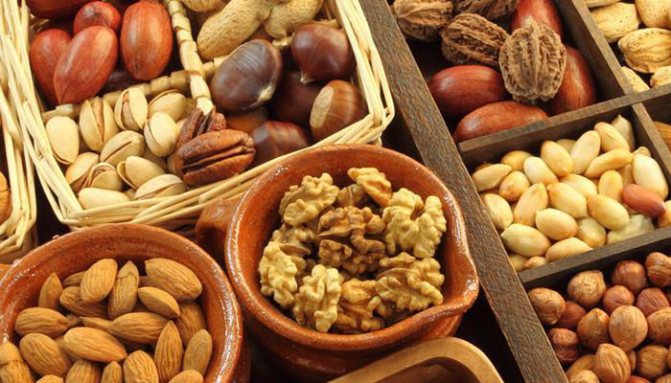
- For pathologies of the pancreas.
- With a tendency to thrombosis.
- If you have intestinal problems.
In general, nuts are considered a healthy product for stomach ulcers. It is very important to eat only high-quality nuts. If any discomfort arises after using them, it is better to discard them immediately. You can reintroduce nuts into your diet after consulting a doctor and only after your stomach condition has stabilized.
Source
How many walnuts can a nursing mother eat?
This product is a possible allergen, so it should be consumed in limited quantities. The optimal daily intake of walnuts for breastfeeding is 3-4 pieces. Since they are high in calories, you can snack on nuts between meals. They satisfy hunger well and improve the quality of breast milk.
You should not exceed the recommended amount, as this may adversely affect the child’s health. Excessive consumption of walnuts can not only cause redness and rashes on the skin, but also cause colic and indigestion. If such a reaction occurs, you should stop using this product for a while.
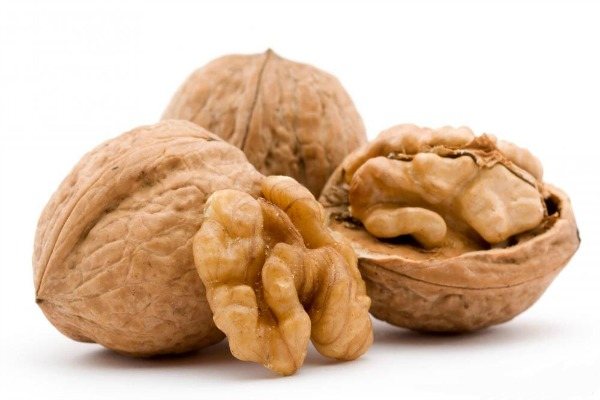
Is it possible to eat too many nuts?
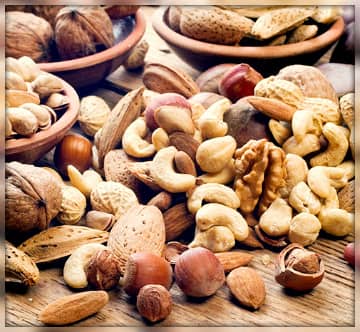
Eating nuts is healthy because they can protect against risk factors for heart disease and other diseases, but it is also possible to eat too many nuts:
- Nuts are high in calories, so eating large amounts of nuts throughout the day can cause people to exceed their target calorie intake without realizing it - doing this "exercise" regularly can lead to weight gain.
- Nuts are also rich in healthy fats, which are good for the body in moderation, but in excess can cause diarrhea and other problems.
- Roasted, salted nuts can add at least as much sodium to your diet as other salty snacks. Anyone who eats salted nuts should pay attention to the label to see how much sodium they are eating. Raw or dry roasted nuts are a healthier alternative.
- Some people may find that nuts upset their digestive system. In this case, eating too many nuts may make them feel "bloated"; nuts are also a common food allergen.
Brown rice milk
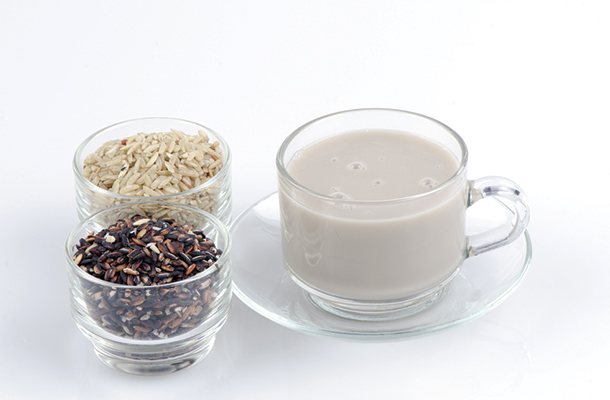
There is no benefit in using refined rice. We advise you to always take only brown. It is a good source of fiber, manganese and selenium. It also contains iron, copper, niacin and folic acid.
Ingredients:
- 3/4 cup boiled rice;
- 3 glasses of filtered water.
Place the rice in a blender, add water and blend until smooth (about 1 minute). You can repeat the process for an even more uniform consistency.











